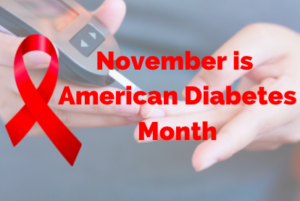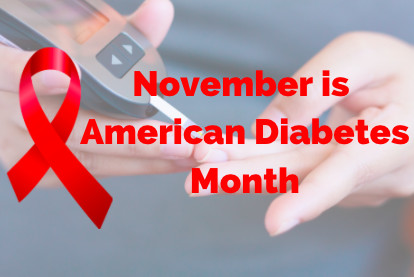American Diabetes Month: Risk Factors and Prevention
 Did you know that November is National Diabetes Month? Over 34 million people suffer from diabetes in America alone. That is approximately 1 in every 10 people. This month is all about coming together and raising awareness about diabetes!
Did you know that November is National Diabetes Month? Over 34 million people suffer from diabetes in America alone. That is approximately 1 in every 10 people. This month is all about coming together and raising awareness about diabetes!
What is Diabetes?
In simple terms, diabetes is a disease that occurs when one’s blood sugar is too high. There are two common types of diabetes. Here is a quick overview:
- Type 1– This type of diabetes is an autoimmune disease, which occurs when the pancreas no longer produces insulin. Insulin is an important hormone that allows blood glucose (or sugar) to enter your cells to then be used for energy. When there is not a substantial amount of insulin in the body, sugar builds up in the bloodstream, which can wreak havoc on your body. Unfortunately, this type of diabetes cannot be prevented and requires lifelong use of insulin.
- Type 2– This type of diabetes is the most common. Type 2 diabetes affects the body’s ability to process blood sugar. Your body may not produce enough or use the insulin it does produce efficiently. Type 2 diabetes can develop at any age or life stage. However, compared to Type 1, this type of diabetes can be managed with nutrition and lifestyle changes.
Diabetes has become more and more prevalent in recent years, which is why celebrating American Diabetes Month is so important. The more people are educated on diabetes and the more it is talked about, the more people can be helped.
What are the Signs?
Like many diseases, there are associated symptoms that you should be on the lookout for. Being aware of your body and paying close attention to the signals it is sending you can help identify your diabetes risk. The sooner symptoms of diabetes are identified, the sooner you can create a plan to live a healthy life with diabetes. Common symptoms of diabetes include:
- Increased thirst and urination
- Increased feelings of hunger
- Fatigue, tiredness, or weakness
- Blurred, or impaired vision
- Numbness, or tingling in the feet or hands
- Sores that do not heal
- Unexplained weight loss
If you or anyone you know is experiencing these symptoms, please consider speaking with your primary care provider. Your doctor will review blood work, explore your family history, and identify other risk factors you may have. Having this discussion with your doctor will help develop an action plan for your health moving forward!
4 Ways to Reduce Your Risk of Diabetes
Although it may seem difficult to prevent diabetes, it is not impossible! Taking the proper steps to improve your diet and adjusting certain lifestyle habits can significantly decrease your risk of diabetes.
If you’re ready to make a change, here are 4 ways to reduce your risk for diabetes:
- Move your body regularly. Frequent exercise has been known to help heart health, reduce blood glucose levels, and increase the body’s response to insulin. Although exercising can be intimidating, try moving your body in ways that work for you! Go on a daily walk around the neighborhood, take a bike ride, or even play your favorite song to dance to for 10 minutes.
- Eat a balanced and healthy diet. Eating a healthy diet is important for everyone. However, it is especially important when wanting to reduce your diabetes risk. Eating “balanced” simply means increasing fruit, vegetable, and high fiber foods in your meals, while reducing the intake of fat, specifically saturated fat, and limiting processed foods. Switch it up in your kitchen and try cooking a plant-based meal for dinner or make the swap from white pastas, rice’s, and breads to hearty, whole grain options.
- Quit smoking. Smoking is bad for one’s health in general, but research suggests that smokers are twice as likely to develop diabetes compared to non-smokers. Decide to quit today.
- Schedule regular doctors’ visits. As mentioned before, if you or someone you know is experiencing symptoms or you have a known history of diabetes – regular checkups with your doctor are a great idea! Stay on top of your health and make an appointment to meet with your doctor today.
As a Certified Diabetes Educator, I specialize in helping people that have diabetes or are at risk for developing diabetes learn how they can properly manage it. I believe in a weight-neutral approach, which means focusing on creating healthy habits and behavioral changes, without a focus on losing weight. My program called Healthy Living with Diabetes has helped so many live a life free of complications.
Now that you know more about diabetes and how I can help those struggling with managing their diabetes, I would love to hear from you!
Your turn to take action: What prevention did you find the most significant? Let me know in the comments below.


Leave a Reply
Want to join the discussion?Feel free to contribute!